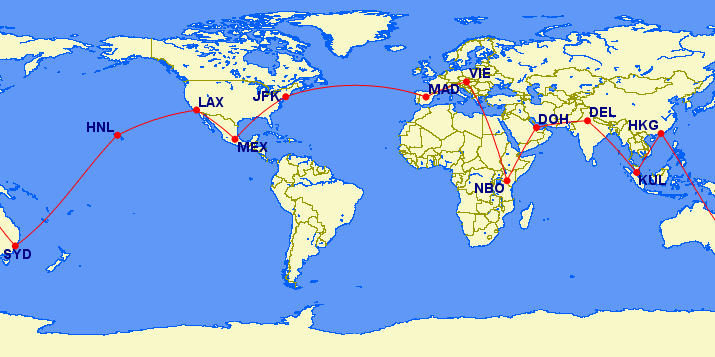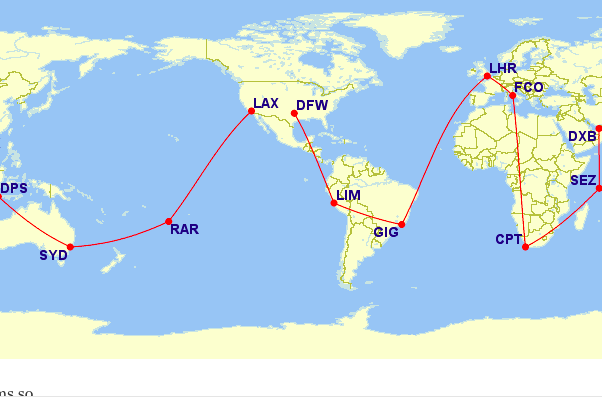Many airlines offer their alliance’s “Round the World” tickets available for miles. In this post I’d like to confront these questions: what are the prices and rules? And are these tickets a good deal?
Of course, each airline is different and each travel plan is different. But this guide should tell you all you need to know about using your miles for round the world tickets, and comparing them to “normal” award redemptions, along with other programs.
In case you’re not familiar, airline alliances offer these flat rate “round the world” tickets that are allowed to circle the globe with some large number of stops as long as you keep moving the same direction (in terms of east to west). Airlines, allow similar tickets available for miles redemption. Many times you could often buy miles cheaper than the paid ticket… but I don’t buy miles. 🙂
One thing I’ll mention for every airline besides prices and rules, is “fuel surcharges” because I’d be frightened to go around the world paying fuel surcharges for every flight!
But first, let’s look at the around the world ticket prices.
United Airlines
Award Prices:
- Economy: 200,000 miles
- Business: 350,000 miles
- First: 450,000 miles
Basic Rules:
- 6 Stops (5 stopovers)
- 16 segments
- Must follow one direction
These prices would appear a lot higher to me if it weren’t for the recent devaluation. But since Star Alliance allows 15 stopovers (16 segments)… the premium of 200,000 miles for economy is suddenly not so bad.
Compared to regular awards: Now a roundtrip to SE Asia is 80k/140/160k. Generally the price is about 2.5 times greater than a regular ticket to the other side of the world. Given that you are allowed 3 times as many stops.
Under the old rules, this would have been criminal. Under the new rules… it’s still not worth it.
Fuel Surcharges? Nope. Good to go.
US Airways
Award Prices:
- 200k
- 300k
- 400k
Basic Rules:
- 6 Stops (5 stopovers)
- 10 segments
- Must follow one direction
Compared to regular awards: Very similar situation to United. If you want 6 stops, this is a reasonable option. But their routing rules are so loose otherwise that you could go “around the world”, just with 1 stop instead of 6.
So it’s a 3x increase on stops for about a 2.5x increase in price. And in some places it’s only 2x the normal price.
Fuel Surcharges? Nope. Good to go.
Air Canada
Award Prices:
- Economy Class – 200,000 Aeroplan Miles
- Business Class – 300,000 Aeroplan Miles
- First Class – 400,000 Aeroplan Miles
Rules:
- A maximum of five stopovers and one open jaw are permitted per reward on allowable routings.
- A maximum of one stopover is permitted in any one city.
- Travel must commence from and return to the same country, and return cannot go beyond the point of origin.
- Must include one transatlantic and one transpacific crossing.
Compared to regular awards: Again, Air Canada also allows 1 stopover regularly. This is 3x increase in stops. And like US Airways it’s a 2x – 2.5x increase in price.
Fuel Surcharges? Yes. Many airlines that have fuel surcharges will pass them on to Air Canada. But not:
Delta Airlines
Award Prices:
- Economy: 180,ooo
- Business: 280,000
Basic Rules:
- Travel must terminate in the country of origin without extending beyond the point of origin.
- Backtracking is not permitted.
- Flights operated by codeshare partners must permit local traffic between the stopover point and the destination.
- The most direct routing applies.
- A maximum of three stopovers per continent is allowed.
- A maximum of six stopovers is allowed for a Round-the-World Award.
Compared to regular awards: What else are you going to do with your SkyPesos anyways?
Fuel Surcharges? Yes.
Lufthansa Airlines
Award Prices:
- Economy: 180,000 miles
- Business: 325,00 miles
- First Class: 480,000 miles
Basic Rules:
- A Round the World Flight Award ticket includes one Atlantic and one Pacific crossing.
- A maximum of ten flight segments (maximum of nine connecting flights) is allowed.
- There must be an interval of at least ten days between the start of the first intercontinental flight and the start of the last intercontinental flight.
- A Round the World Flight Award ticket remains valid for twelve months once issued.
- A maximum of seven stopovers is allowed.
Compared to regular awards: Lufthansa… is complicated. Their regular awards allow 2 stopovers and 2 open-jaws. However, their regular awards that touch three regions is priced 100k/185k/290k. Which, that’s a heck of a lot for a trip to Bangkok that lays over in Japan.
So your stops are going from 3 to 8. However, your price is barely going up.
Although these prices are high, many awards are really expensive with Lufthansa anyways. So on one hand, it’s an interesting use of hard to use miles.
On the other hand, there are some great deals, like roundtrip to Europe for 50,000 miles with two stopovers. Plus, it’s a lot easier for me to earn 50,000 LH miles than 180,000.
Fuel Surcharges? Yes.
Distanced Based Awards
American Airlines
I just wrote about the American Airlines Explorer Awards, and to be honest that is their round the world ticket. It’s a get what you pay for, as all distanced based award charts are, but in this case it kills the other round the world tickets.
Award Prices:
- Economy: 160,000 miles
- Business: 220,000 miles
- First: 330,000 miles
This is the most you could ever pay on the explorer award chart and it’s still way cheaper than anyone else.
Rules:
- Max of 16 segments
- Unlimited stopovers!
When you compare this to everything mentioned so far, it’s a no brainer. You could design a seriously awesome ticket.
The following route has 20,000 miles to spare and 4 segments!:
Actually this would fall into an even lower price bracket (140k, 190k, 280k).
Fuel Surcharges? No. Only on British Airways (and a small fee on Iberia).
Read the post American Airlines Explorer Awards.
ANA
Max Award Prices:
- Economy: 160,000 miles
- Business: 220,000 miles
- First: 340,000 miles
The prices are actually really similar to American’s at this higher level.
And I have an entire post on smaller routes for Exploring ANA’s Stopovers. With this ticket 8 stopovers are allowed. Which is a lot. But on the other hand you get 4 stops anyways. So you’re really doubling the amount of stops you get. So it depends on the price of the route, but it looks like a good deal from this angle.
Fuel Surcharges? Yes! The real problem here is the amount you would end up paying in fees. It’s scary to think about. You’d have to be really careful and there are basically no options for getting to Asia and back without this fee.
So despite being one of the most under rated airlines, this would be too much.
Read more about ANA Stopover Rules and Ideas.
British Airways
BA actually has the most complicated pricing program simply because it’s possible to save miles (aka Avios) by adding stopovers. If you’re not familiar with this concept, I wrote a series about it here: Breaking BA Avios By Using Stopovers.
Prices: Well, what I recommend is to use the Avios Tool to search from continent to continent. It only shows one connection at a time so you have to do it from region to region. But this way, you can piece together a very reasonably priced ticket around the world.
Really, I think the award prices can be comparable to the other distance based programs. However, you get as many stops as you want. So in a sense, it’s unlimited stopovers because you pay segment by segment anyways.
Fuel Surcharges? Yes. Very high fuel surcharges on many airlines including British Airways itself.
Conclusion
AA is looking pretty awesome for such a route. More stopovers and lower prices.
Of course, these kind of awards are for people who have the time to see the world in one vacation. While this isn’t on my short list, I do think a trip like this would be darn awesome. Just a lot of flying…







I’m with you – these are the kinds of trips that would be awesome if I had the ability to see the world in one go over a 2-3 week period, which, tragically, I do not 🙂
But I agree with what you’re saying that in a lot of cases you can get nearly the value by just taking advantage of some of the sweet spots in the routing rules
Ironically, the thing that keeps me from doing it is that I have too much time and I don’t want to be bound by the dates I book ahead of time.
But maybe some of them have loose change rules. If so, I would definitely try one.
If you do use ANA, start in Brazil…
And can potentially position yourself to skip the last leg so you don’t have to come back to Brazil
how do you do it (start in GIG) if in the us using usair miles? I did a rtw using 130k aa miles.
Doesn’t that only drop it for that one leg or does ANA drop it for the entire trip?
Drew, take a look at Tocqueville’s trip report for more info (I’m not affiliated with him, but that’s where I learned about ANA and ex-Brazil ticket)
You missed a bit on info:
“Fuel Surcharges? Yes. Many airlines that have fuel surcharges will pass them on to Air Canada. But not:”
Also if you want to calculate avios quicker – use wandr.me, tools, Avios calculator.
Darn. I think I posted my chart in a post before, but I’ll try to edit it when I get to italy. Thanks for letting me know.
One thing that’s making it hard to read your posts is that you’re not using “your” and “you’re” correctly. It’s hard to understand your point because of that! Thanks.
You don’t have the see the entire world in one shot. Star Alliance allows you 365 days from the time you start your trip to the time you have to end it.
I’m planning of doing 3 months of traveling, buy a ticket to go home half way to the trip and then come back 4 months later after I’ve saved up some cash to finish the rest of my trip 🙂